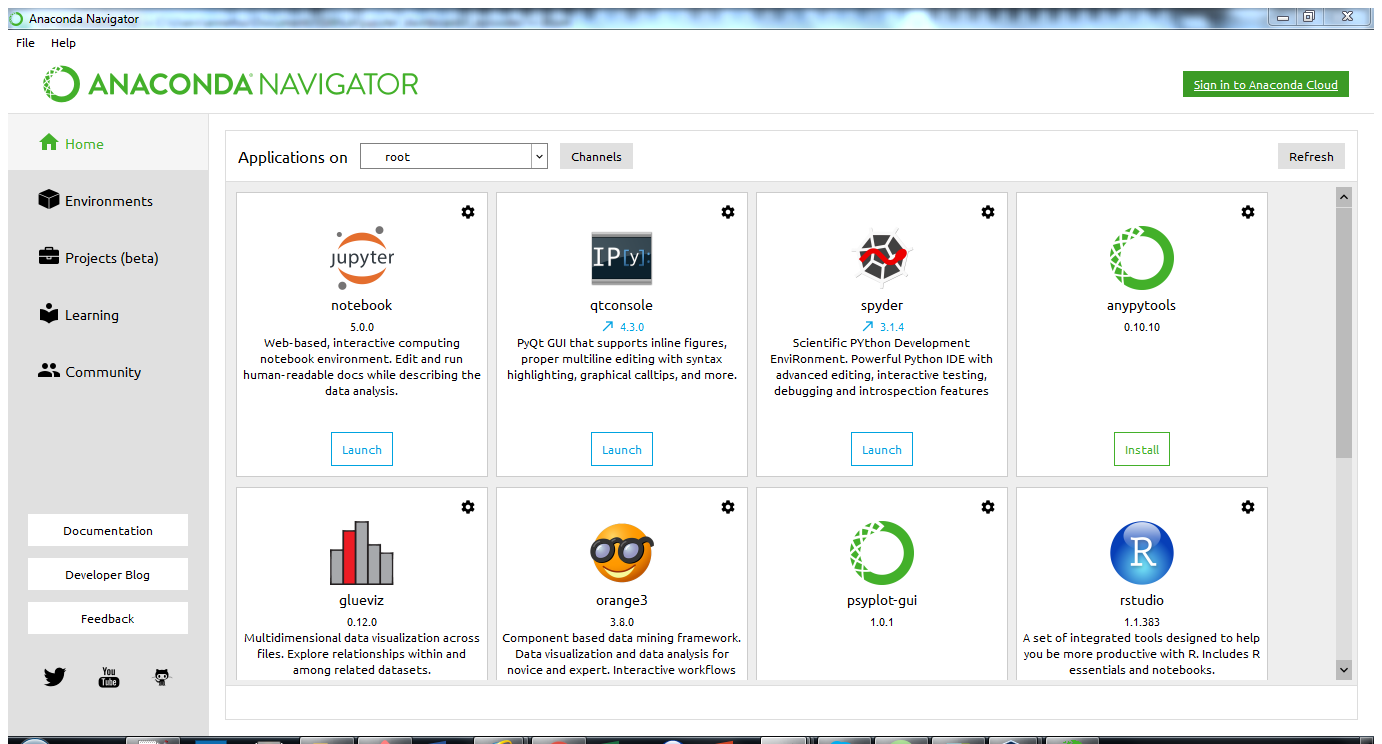RStudio is an integrated development environment (IDE) for R. It includes a console, syntax-highlighting editor that supports direct code execution, as well as tools for plotting, history, debugging and workspace management.
- The problem is that you really only need 1 version of Anaconda. A lot of people think that is that if you install a Python 2 version of Anaconda, you are stuck with Python 2. Anaconda is also an environment manager and makes it very easy to go back and forth between Python 2 and 3 on a single installation of Anaconda (learn more here).
- Miniconda is a free minimal installer for conda. It is a small, bootstrap version of Anaconda that includes only conda, Python, the packages they depend on, and a small number of other useful packages, including pip, zlib and a few others. Use the conda install command to install 720+ additional conda packages from the Anaconda repository.
Download the installer:
Miniconda installer for macOS.
Anaconda installer for macOS.
Verify your installer hashes.
Install:
Miniconda---In your terminal window, run:
Anaconda---Double-click the
.pkgfile.
Follow the prompts on the installer screens.
If you are unsure about any setting, accept the defaults. Youcan change them later.
To make the changes take effect, close and then re-open yourterminal window.
Test your installation. In your terminal window orAnaconda Prompt, run the command
condalist. A list of installed packages appearsif it has been installed correctly.
Installing in silent mode¶
Note
The following instructions are for Miniconda. For Anaconda,substitute Anaconda for Miniconda in all of the commands.
To run the silent installation ofMiniconda for macOS or Linux, specify the -b and -p arguments ofthe bash installer. The following arguments are supported:
-b---Batch mode with no PATH modifications to
~/.bashrc.Assumes that you agree to the license agreement. Does not editthe.bashrcor.bash_profilefiles.-p---Installation prefix/path.
-f---Force installation even if prefix -p already exists.

EXAMPLE:
The installer prompts “Do you wish the installer to initialize Miniconda3 by running condainit?” We recommend “yes”.
Note
If you enter “no”, then conda will not modify your shell scripts at all. In order to initialize after the installation process is done, first run source<pathtoconda>/bin/activate and then run condainit.
Download Anaconda Navigator For Mac
MacOS Catalina
If you are on macOS Catalina, the new default shell is zsh. You will instead need to run source<pathtoconda>/bin/activate followed by condainitzsh.
Updating Anaconda or Miniconda¶
Open a terminal window.
Navigate to the
anacondadirectory.Run
condaupdateconda.
Uninstalling Anaconda or Miniconda¶
Open a terminal window.
Remove the entire Miniconda install directory with:
OPTIONAL: Edit
~/.bash_profileto remove the Minicondadirectory from your PATH environment variable.Remove the following hidden file and folders that may havebeen created in the home directory:
.condarcfile.condadirectory.continuumdirectory
By running:
Format
The workshop consists of explanatory discussions interspersed with hands-on exercises. We strongly encourage you to bring a laptop with all required packages installed in order to fully participate. We will also have office hours with CZI computational biology staff available in the morning to help troubleshoot any installation issues before class begins.
Installation guide (before class)

Anaconda Python For Mac
1. Install Python via Anaconda
Even if you have previously installed Python, please install Anaconda for Python version 3 (available on OSX, Linux, and Windows). You can simply click through the install wizard (no customization required, all the defaults are fine).
Anaconda is package manager, which means that it helps coordinate your Python installation and related packages (useful code written by other people for performing specific tasks) for you so that you have a consistent environment (the version of Python and the version of the code in each package that your computer looks at when doing your analysis).
You should now see an icon for 'Anaconda Navigator' in your Applications folder (mac) or the Start menu (Windows). Please contact the instructors if you do not see this icon!

2. Install required packages (for Mac OS)
2A. Install Bioconda
Not everyone who uses Anaconda is a biologist. As a result, some biology-specific packages are only available in the Bioconda channel (collection of packages).
- Open Anaconda Navigator.
- Click on
Environmentsin the left sidebar - Click on
Channelsin the top middle of the screen - Click on
Add... - In the bottom text box, type
biocondaand pressEnter - Press
Update channels
2B. Download the course config file
To handle installation of all the Python packages required for the workshop (both days, all tracks), we have prepared a configuration file that tells Anaconda how to configure your environment.
- Download the configuration file called
sfn-workshop-mac.ymlhere. Save it an a spot you'll remember. - Open Anaconda Navigator
- Click on
Environmentsin the left sidebar - Click on
Importin the bottom left - Enter
sfn-workshopas the Name, and browse for thesfn-workshop-mac.yamlfile you just downloaded - Press
Import
2. Install required packages (for windows)
2A. Download the course config file
To handle installation of all the Python packages required for the workshop (both days, all tracks), we have prepared a configuration file that tells Anaconda how to configure your environment.
- Download the configuration file called
sfn-workshop-windows.ymlhere. Save it an a spot you'll remember. - Open Anaconda Navigator
- Click on
Environmentsin the left sidebar - Click on
Importin the bottom left - Enter
sfn-workshopas the Name, and browse for thesfn-workshop-windows.yamlfile you just downloaded - Press
Import
2B. Install scanpy (for Windows users in the single-cell track only)
- Click on the green play button next to the
sfn-workshopand choose 'Open terminal' - Enter
python3 -m pip install scanpyand pressEnter
3. Check your installation
- Open Anaconda Navigator
- Click on
Environmentsin the left sidebar - Select the
sfn-workshopenvironment from the list. This may take several minutes. - Click on the green
playbutton that appears - Select
Open with Jupyter Notebookfrom the list
You should get a browser tab that says 'Jupyter' at the top and lists all the files on your computer. This might not seem like much, but is all you need to get started! :)
If this does not work, please come to office hours before class so the CZI computational biology team can help you
4. Download course files
For the imaging track
Go to https://github.com/sofroniewn/2019-ndcn-comp-bio-imaging
For the single cell track
Go to https://github.com/chanzuckerberg/scRNA-python-workshop
Clone or download contents
If you are comfortable cloning a repository with git, we encourage you to do so. Otherwise, click the green 'clone or download' button and choose 'download zip'. We encourage you to do this the evening before class, as we may make some last-minute updates to the material.
5. Bonus: install fun visualization tools (optional)
- Open a terminal window (Mac: Applications > Utilities > Terminal; Windows: Start > Windows System > Command Prompt)
For the imaging track:
In the terminal window, copy and paste the following and press
Enter:python3 -m pip install napari
To test your installation of napari, type napari in the next terminal line and press Enter. You should see an application window open up.
For the single-cell analysis track:
In the terminal window, copy and paste the following and press
Enter:python3 -m pip install cellxgene
To test your installation of cellxgene, type cellxgene in the next terminal line and press Enter. You should see something like this:Usage: cellxgene [OPTIONS] COMMAND [ARGS]... Options: --version Show the version and exit. --help Show this message and exit. Commands: launch Launch the cellxgene data viewer. prepare Preprocesses data for use with cellxgene.
If this does not work, and you would like to try out the visualization tools in class, please come to office hours before class so we can help you.

